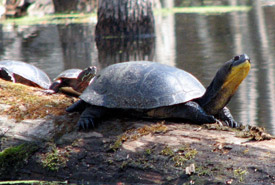Blanding’s turtle in the Ottawa Valley
A threatened species to be protected
Blanding's Turtle (Photo by NCC)
The Blanding’s turtle is a species deemed threatened in Quebec since 2009. It's black, domed shell, often marked with yellow and tawny flecks, can reach up to 28 centimetres in length. This reptile is easy to recognize thanks to its bright yellow throat and chin.
The species is found in wetlands, beaver ponds and lakes with shallow water and mucky bottoms, as they are rich in aquatic vegetation and organic matter.
Formerly, the Blanding’s turtle's range was limited to the southern Ottawa Valley region, specifically in the municipalities of Bristol, Clarendon and Shawville, as well as in a large section of Gatineau Park. Until recently, the westernmost sightings occurred in Sheenboro.
"To ensure the long-term sustainability of Blanding’s turtle populations, habitat conservation is very important. Protecting against loss, degradation and fragmentation requires a better understanding of the turtle’s distribution," explained Caroline Gagné, project manager for the Nature Conservancy of Canada's (NCC's) Quebec Region.
A successful inventory
In 2014, teams were deployed in the field to attempt to spot or confirm the presence of Blanding’s turtles in areas of the Outaouais that had not yet been surveyed. Collectively, they covered 260 hectares (640 acres). To put that into perspective, it is the equivalent of nearly 1,650 NHL-sized hockey rinks. Each of the traps were checked daily in order to count the captures, change the sardine can, which served as turtle bait and, of course, release the turtles.
Ultimately, NCC was able to observe that Blanding’s turtle’s habitat had extended to the west. Indeed, several specimens were recorded in the Sheenboro area, near the Outaouais river, on an NCC property.
The Ottawa Valley
Because of the Ottawa Valley's diversity of habitats and its natural wealth, the Nature Conservancy of Canada has been working here for nearly two decades, protecting 3,850 hectares (9,500 acres) of ecologically sensitive lands.
This region on the banks of the Ottawa River is considered by experts to be one of Quebec’s biodiversity hot spots. It is home to more than 85 rare floristic species, several of which are associated with limestone outcrops from the Precambrian era, which are typically found in the Ottawa Valley.
Help protect Blanding’s turtles
- Record your observations of living, hurt or dead turtles by filling out the form at carapace.ca. A photograph is always proof positive!
- Observe the turtles from a distance! Never remove them from their natural habitat, and never move them to another habitat.
- If you find a turtle on the road, help it by encouraging it to cross in the direction it’s headed; don’t put it back in the water or move it elsewhere, and, above all, never hold it by its tail.
- Avoid drying out wetlands created by beavers, dismantling their dams or even removing branches and tree trunks lying at the water’s edge.




